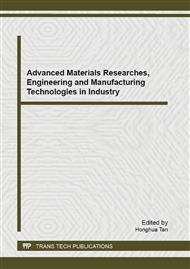[1]
Idawati ismail, A. A. S., Abd latif, S., (2003).
Google Scholar
[2]
Le roy, r., Parant, e. & Boulay, c. (2005) Taking into account the inclusions' size in lightweight concrete compressive strength prediction. Cement and Concrete Research, 35, 770-775.
DOI: 10.1016/j.cemconres.2004.06.002
Google Scholar
[3]
Babu, K.G., Babu, D.S., Wee, T.H., (2005) Properties of lightweight expanded polystyrene aggregate concretes containing fly ash. Cement and Concrete Research, 35 pp.1218-1223.
DOI: 10.1016/j.cemconres.2004.11.015
Google Scholar
[4]
Miled, K., Sab, K. & Le roy, R., (2007). Particle size effect on EPS lightweight concrete compressive strength: Experimental investigation and modelling. Mechanics of Materials, 39, 222-240.
DOI: 10.1016/j.mechmat.2006.05.008
Google Scholar
[5]
BS EN 933-1., (1997). Tests for geometrical properties of aggregates. Part 1: Determination of particle size distribution – Sieving method.
DOI: 10.3403/01236185u
Google Scholar
[6]
BS EN 12350-2., (2009). Testing fresh concrete. Part 2: Slump-test.
Google Scholar
[7]
BS EN 12390-3., (2009). Testing hardened concrete. Part 3: Compressive strength of test specimens.
Google Scholar
[8]
BS EN 12504-4., (2004). Testing concrete. Part 4: Determination of ultrasonic pulse velocity.
Google Scholar
[9]
Tang, W. C., Lo, Y., Nadeem, A., (2008). Mechanical and drying shrinkage properties of structural-graded polystyrene aggregate concrete. Cement and Concrete Composites, 30, pp.403-409.
DOI: 10.1016/j.cemconcomp.2008.01.002
Google Scholar
[10]
Kan, A. & Demirboğa, R., (2009). A novel material for lightweight concrete production. Cement and Concrete Composites, 31(7), pp.489-495.
DOI: 10.1016/j.cemconcomp.2009.05.002
Google Scholar
[11]
Khatib, J, M., and Mangat, P, S. (1995).
Google Scholar
[12]
Khatib, J., Clay, R. (2003) Absorption characteristics of metakaolin concrete. Cement and concrete research [Online]. 34 (1), pp.19-29 [cited 16 December 2008], Available from Science Direct <http: /www. Sciencedirect. com>.
DOI: 10.1016/s0008-8846(03)00188-1
Google Scholar
[13]
Babu, K.G., Babu, D.S., Wee, T.H., (2006) Effect of polystyrene aggregate size on strength and moisture migration characteristics of lightweight concrete. Cement and Concrete Composites, 28 pp.520-527.
DOI: 10.1016/j.cemconcomp.2006.02.018
Google Scholar


